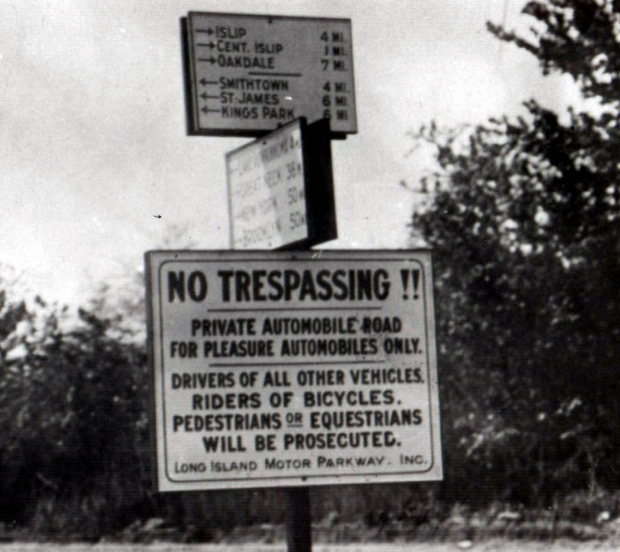A Motor Parkway Sign at Wheeler Road in Suffolk County

Throughout the Long Island Motor Parkway, there were signs providing directions and "No Trespassing" signs. This photo shows a typical Motor Parkway sign placed in Suffolk County.
Heading east to Lake Ronkokoma, the last parkway bridge went over Deer Park Avenue in Suffolk County. Over 20 additional bridges were planned but never built due to lack of funds. These "No Trespassing" signs were placed on intersections with major public roads to keep unwanted traffic off the Motor Parkway including; trucks, pedestrians and equestrians.
It is possible to find the location of this specific sign based on the two directional signs. This direction sign and the "No Trespassing" sign appeared for a driver heading east on the Motor Parkway. A right turn brought the driver south to Islip (4 miles), Central Islip (1 mile), and Oakdale (7 miles). A left turn brought the driver north to Smithtown (4 miles), St. James (6 miles) and Kings Park (6 miles).
This direction sign was seen by a driver heading south on a public road at the interesection with the Motor Parkway. A left turn on to the Motor Parkway brought the driver heading to Lake Ronkokoma, 4 miles away. A right turn on to the Motor Parkway brought the driver west to Great Neck (36 miles), New York (50 miles) and Brooklyn (50 miles).
Based on the above mileages, the most likely location of this sign was the intersection of the Motor Parkway and Wheeler Road near Central Islip and Hauppauge.





Comments
Thanks for your continuous updates and hard work on this very interesting piece of L I history. Even in the off season there’s always something happening on your blog.
While perhaps lost in history looking at this photo I wonder what those living near the motor parkway thought about it? Those to whom the no trespassing signs were directed. For that matter I wonder was the road used on a daily basis? Was it a question of just paying the toll? or was their a more exclusive element to it? I suppose the mere ownership of a motor car in those early days itself made you a member of the upper crust.
I wonder was there a resentment to the Motor Parkway and it was a factor in Robert Moses parkways which came what 20 years later?
Imagine in today’s society a major private road without any public access would never be tolerated.
Regards,
Ken Wiebke